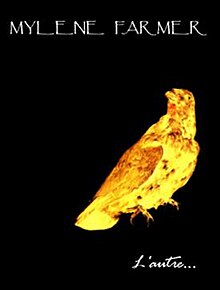L'Autre (Mylène Farmer album)
| L'autre... | ||||
|---|---|---|---|---|
 |
||||
| Studio album by Mylène Farmer | ||||
| Released | April 9, 1991 | |||
| Recorded | Paris | |||
| Genre | Synthpop, darkwave | |||
| Length | 53:48 | |||
| Label | Polydor | |||
| Producer | Laurent Boutonnat | |||
| Mylène Farmer chronology | ||||
|
||||
| Alternative cover | ||||

Collector edition
|
||||
| Singles from L'autre... | ||||
|
||||
| Professional ratings | |
|---|---|
| Review scores | |
| Source | Rating |
| AllMusic | |
L'autre... is the third studio album by Mylène Farmer, released on April 9, 1991. It contains the singer's biggest hit, "Désenchantée", which was number-one in France for nine weeks, and other three top ten hits. The album was generally well received by the critics and was a great success in terms of chart and sales (#1 for twenty weeks), becoming the best-selling album throughout the singer's career and the twenty second best-selling album of all time in France.
After her first concert tour in 1989, Mylène Farmer released the new song "À quoi je sers..." which was a synthesis of her musical work and marked the end of an age. While the album En concert was charted, she took advantage of the following months to travel in various countries including India, and to discover new literary works, such as those of Emil Cioran in which she drew inspiration. She also became interested in painting and visited many art galleries and museums that were also sources of inspiration for her. Then she decided to compose a third studio album which was recorded at the studios Mega. This one showed an evolution of the singer : indeed, the texts marked a change of mindset and testified to a transformation in her life including a greater openness to the other (hence the album's title). From that moment, the singer decided to more express herself and went to the meeting of her fellow man. Writing for five months, this album was the result of all what has happened to Farmer "at personal and artistic levels".
For this new album, Farmer changed her hairstyle because she wanted a different look without changing : she opted for a very short hair cut, made by Jean-Marc Maniatis. The album cover, much more luminous than that of Ainsi soit je..., shows Farmer lying on a white background with a crow on her shoulder (this cover was undoubtedly inspired by the Edgar Allan Poe's poem The Raven). The singer explained that the crow on the cover was not for her a sign of doom, but had rather a role of a protective ally. The album was eventually released in April 1991, one month after the marketing of the single "Désenchantée" which was #1 on the French Singles Charts. It was released in Europe, in francophone countries and Japan.
...
Wikipedia
